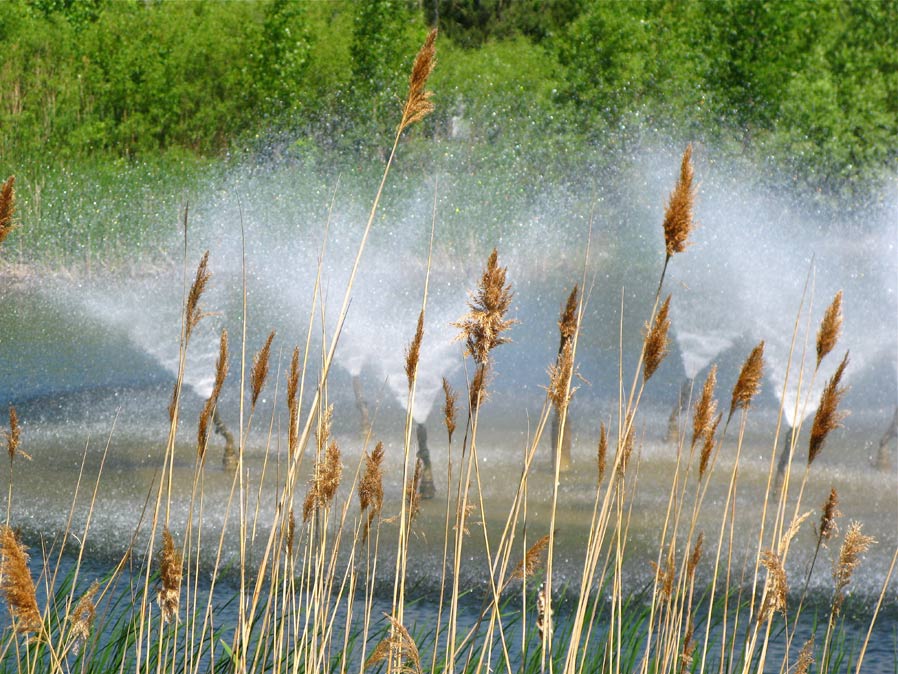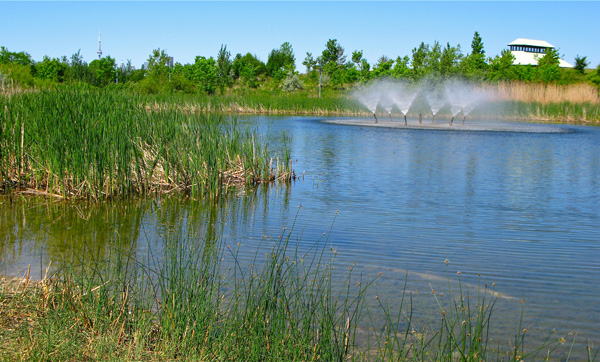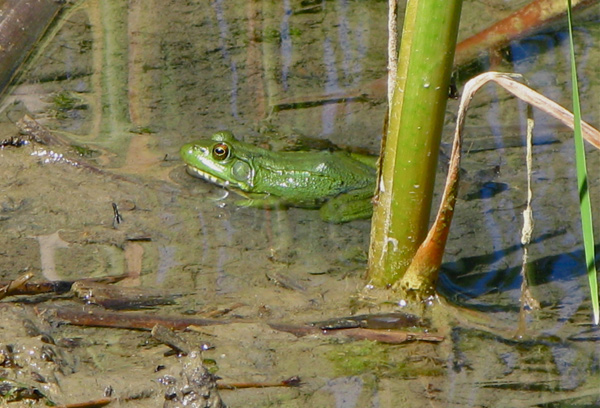Common reeds, Phragmites australis, by the fountain in the reflecting pond at Woodbine Park May 30, 2010. © BCP 2010
Is it my imagination, or do the reed beds in Woodbine Park keep getting bigger?
At first, I was a huge fan of these reeds. (If my research powers are intact since my recent European sojourn, they are Phragmites australis — the common reed.)
I love the way they have a distinctive look in every season. In the fall, with their feathery seed heeds bending in the breeze. In the winter, bending under the weight of freshly fallen snow. Above all, in the spring, when the advance of the new growing season can be gauged by the moment the male red-winged blackbirds arrive from their overwintering grounds down south, reach our marshes, ponds and river edges where they land on the reeds, bending them almost completely over with their weight. It’s from these reeds the blackbirds loudly announce their return to all parties — avian and otherwise.
Woodbine Park’s reflecting pond, looking west towards the CN Tower, hazily visible in the top left of picture. © BCP 2010
Today, an absolutely perfect summer day — the kind that makes you grateful to be alive on planet Earth — I thought the reeds to be as lovely as ever. But I noticed they seemed to be taking over the ponds in this relatively newly constructed park.
Looking them up online, it wasn’t long before I found out that these reeds are considered to be aggressively invasive non-native weeds that are severely phrowned upon by ecologists and biologists. Why? Because they spread extremely rapidly, forming dense thickets that effectively choke out many native species that are part of complex marshy ecosystems. That seems to be what is happening at Woodbine Park.
There’s no doubt the park’s teeming population of red-winged blackbirds has found the reeds to their liking. But what species of native grasses and sedges — and all the flora and fauna they are normally associated with — are being crowded out?
Who knew we had a purple loosestrife situation right in our own backyard?
Green frog, Rana clamitans, at Woodbine Park today. © BCP 2010
I’m happy to report, though, that not all other life has been pushed to the margins at Woodbine. On my walk around the reflecting pond, I heard frogs bellowing before I actually saw any. But by listening closely, then staying very still, I was able to locate one of these noisy amphibians. He was right at the water’s edge, partially submerged. And he was playing a banjo.
Er, no. It just sounded that way. The Nature Conservancy of Canada website calls the green frog “the banjo player of the swamps.” Here’s what else the site says about these amphibians native to Ontario: “The Green Frog’s nickname, “banjo frog,” may explain Kermit the Frog’s affinity for the banjo. Their call, which only the males make, sounds just like a plucked banjo string or rubber band. But unlike Kermit, and despite its name, the Green Frog is not always green!” (Clicking on the banjo string link will take you to an audio file of the frog’s croaking.)
Hee’s another interesting factoid I found out about this cute little frog: the flat disc just behind the frog’s eye is actually his eardrum, called a tympanum. (All the better to hear you with, my pretty!)
On my next trip to Woodbine Park, I’ll see if I can find any other species of frog native to Ontario.
And I’ll try to find out what, if any, damage is being done to the park by the Phragmites reeds. Perhaps the phear and loathing is unjustified?
© BCP 2010






1 comment